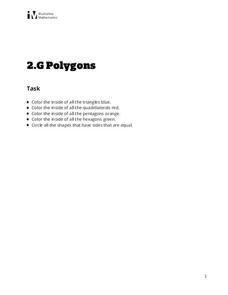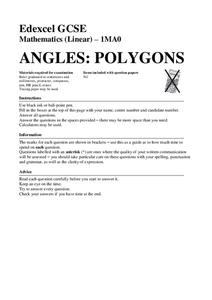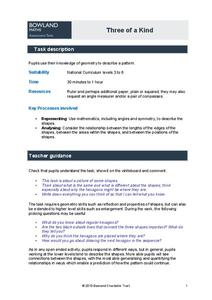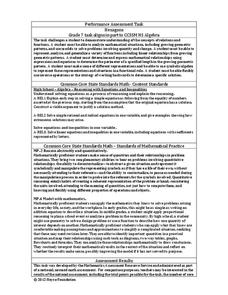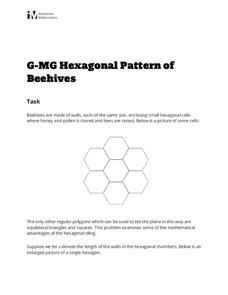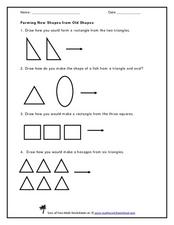Arcademics
Kangaroo Hop
Scholars play against three other participants to show what they know about geometric figures. Starting at the beginning, kangaroos jump from shape to shape to match the figure to the displayed word and make their way to the finish line.
Radford University
Tiling a Kitchen Floor
Cover the floor with math. Pupils work to determine the proper shape to cover a kitchen floor. They first determine the number of tiles to purchase and configure their placement to reduce the amount of waste. Teams finish by creating a...
California Education Partners
Fun on the Farm
Let imaginations run wild as participants design animal pens. A performance task challenges young mathematicians to determine the perimeter or a missing side length of different animal pens. They then design pens that meet given...
Corbett Maths
Hexagon Inscribed Within a Circle
Mark off the length of the radius around the circle. Using a compass, the presenter shows how to construct a regular hexagon in a circle. Pupils see how triangles formed in the hexagon are equilateral, allowing for the construction to...
Illustrative Mathematics
Polygons
Identify shapes based on their attributes. Second graders are tasked to color triangles, quadrilaterals, pentagons, and hexagons specific colors. The one thing these shapes have in common? They are all polygons.
Noyce Foundation
Lyle's Triangles
Try five problems on triangles. Levels A and B focus on shapes that can be created from right triangles. Level C touches upon the relationship between the area of a six-pointed star and the area of each triangle of which it is composed....
Mathed Up!
Angles in Polygons
Show your class that finding angle measures is a regular calculation with a resource that provides 12 problems dealing with the measures of angles in regular polygons. Pupils use formulas for the sum of measures of angles in a polygon to...
Worksheet Web
Let it Snow
After reading an informational text detailing the ins and outs of snowflakes, scholars draw their own special design then work cooperatively to role play a snowman building scenario.
Bowland
Three of a Kind
One is chance, two is a coincidence, three's a pattern. Scholars must determine similarities and differences of a regular hexagon undergoing dilation. They look at lengths, angles, areas, and symmetry.
Inside Mathematics
Hexagons
Scholars find a pattern from a geometric sequence and write the formula for extending it. The worksheet includes a table to complete plus four analysis questions. It concludes with instructional implications for the teacher.
MENSA Education & Research Foundation
Shapes - Kindergarten
Extend scholars' learning experience with a unit consisting of five shape lesson plans, an extension activity, assessment, and rubric. Begin by reading a story about shapes, then conduct an overview and assign pupils' their first...
World Wildlife Fund
Arctic Take 6
The magic number is six! Using a 6x table, young math stars practice adding, subtracting, multiplying, and dividing two-digit numbers with the number six. This worksheet also touches on making tessellations with hexagons.
K-5 Math Teaching Resources
Pattern Blocks
Who needs to buy pattern blocks when you have this printable pattern block template? Including triangles, squares, trapezoids, rhombuses, and hexagons, this resource offers endless possibilities for teaching children about geometric shapes.
Kids Can Have Fun
Cut and Paste Shapes
Engage youngsters in exploring the wonderful world of shapes with this series of cut-and-paste activities. Offering a variety of materials from printable pattern blocks to a series of matching exercises, this resource will have your...
Illustrative Mathematics
Hexagonal Pattern of Beehives
Young geometers and biologists investigate the math of nature in an activity that is just the bee's knees. Participants will study the tessellations of hexagons in a beehive, along with the natural rationale behind the specific shape....
Curated OER
Spotting Polygons
See all sides of the story with a worksheet on geometric shapes! After studying the example at the top, which matches polygons with solid figures, second graders circle shapes that are named in the directions. Next, they match polygons...
Curated OER
2-Dimensional Shapes: Looking at Shapes
Help scholars identify shapes more thoroughly by counting their attributes. They examine eight 2-dimensional shapes, recording the number of sides and corners for each writing the name. Consider creating a class poster together before or...
Curated OER
Naming Polygons
What polygon is this? Young geometers categorize shapes by circling all the quadrilaterals in a set of figures. Next, they write the names of 10 polygons using a visual guide as reference. Review the guide together before they start if...
Curated OER
2-Dimensional Shapes: Naming Shapes
Get to know eight shapes by name: square, rectangle, triangle, pentagon, hexagon, and octagon. Young geometers write the correct name below each of these shapes, using a word bank for guidance. Then, they draw two of the shapes (hexagon...
Curated OER
Naming 2-Dimensional Shapes
Inside each of these two-dimensional shapes, scholars identify the figure by writing its name. There is a word bank for them to work from, but some shape names are used multiple times. There are six identifiers they use: pentagon,...
Curated OER
2-Dimensional Shapes: Drawing Shapes
Some of the best practice with shape identification comes from drawing the figures first-hand. Young geometers draw nine two-dimensional shapes: rectangle, circle, square, pentagon, hexagon, octagon, triangle with three equal sides,...
Curated OER
Forming New Shapes from Old Shapes
Shapes can be joined together to make new shapes! Young geometers experience this phenomenon as they examine four shape challenges in this worksheet. Scholars create a rectangle from two right triangles and a fish from an oval and a...
Curated OER
Shape Sort
Sorting is a great way to familiarize learners with basic shapes in this partner activity. Pairs have sixteen shape cards with various sizes and types of triangles, rectangles, hexagons, and squares. They have four category cards in...
World Wildlife Fund
Take 6
Investigate the various properties of the number six with this elementary math lesson. From simple addition, subtraction, multiplication, and division problems to the creation of hexagonal tessellations, this lesson covers all aspects of...






